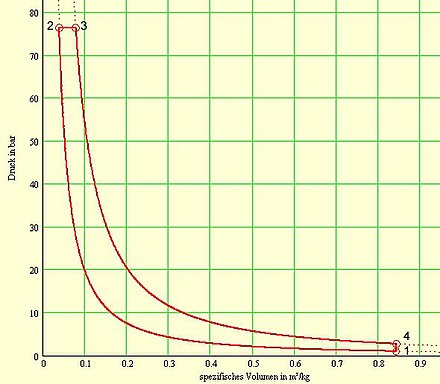Diesel cycle
The diesel cycle ( constant-pressure process ) is by the German engineer Rudolf Diesel named comparison process in which the heat at constant pressure ( isobaric takes place). These, unlike the stands Otto cycle ( constant volume process ) as compared with process heat at constant volume ( isochoric ). Both cycle processes are not suitable for calculating the thermodynamic conditions in internal combustion engines. The mixed cycle process must be used for piston engines .
Process flow
The comparison process consists of four changes of state of an ideal gas . The gas exchange cycle (isobaric discharge and suction) is not taken into account. The four process phases are:
- isentropic compression (1 → 2)
- isobaric heat supply (2 → 3) (therefore equal pressure process!)
- isentropic expansion (3 → 4)
- isochoric heat dissipation (4 → 1)
| State diagram and data from a calculation example | |
|---|---|

Diesel process in the pV diagram (isentropes drawn with dotted lines)
|

Diesel process in the Ts diagram (isobars drawn with dotted lines)
|
The area enclosed by the line (1 → 2 → 3 → 4) corresponds to the specific work.
The four process steps are as follows:
- Compressing the load: line 1 → 2
- Work (combustion and expansion): line 2 → 3
- Working (expansion without heat supply): line 3 → 4
- Ejecting the burned charge: line 4 → 1
Efficiency
The efficiency of the diesel process depends on the geometric compression ratio , the full pressure or constant pressure ratio , which in turn depends on the amount of heat supplied (in the real engine, this is the injection ratio ), and the isentropic coefficient .
Comparison processes only serve to clarify basic processes and relationships. Here, too, air is usually used as the working medium, whereby for simplification - far removed from reality - temperature-independent material properties (heat capacity and isentropic exponent) are assumed ( ideal gas ). The thermal efficiency of the diesel process can then be determined as follows:
The term containing the full pressure ratio is> 1. Therefore, with the same compression ratio, the efficiency would be lower compared to the constant space process. Due to the heat supply in the expansion phase, however, the pressure and temperature peaks are lower, which is why a higher compression ratio is possible with the same thermal load and thus ultimately a greater efficiency of the constant pressure process.
- ; Compression and expansion ratio. V 2 is the compression volume and V 1 is the expansion volume. The higher the expansion ratio, the higher the efficiency.
- ; Full pressure ratio. V 3 depends on the energy supply.
- ; Isentropic exponent.
- ; Heat capacity at constant pressure.
- ; Heat capacity at constant volume.
The equations for the state changes
- ; Compaction pressure. p 1 is the initial pressure in the cylinder, e.g. B. 1 bar.
- ; Compression temperature. T 1 is the initial temperature in the cylinder before compression, e.g. B. 400 K (approx. 127 ° C).
- ; Maximum temperature after constant pressure combustion
- ; Volume after constant pressure combustion.
- ; Pressure after expansion
The real diesel engine
The deviation of the comparison process from the real process is not only very large because of the simplified assumptions. In the real engine, constant-space combustion sometimes takes place, so that the maximum pressure is at least twice as high as the compression pressure. Therefore, a better comparison process (also for gasoline engines) is the Seiliger cycle with a proportion of constant space and another proportion of constant pressure heat supply. The proportion of equal pressure is higher in a real diesel engine, which is why a higher compression ratio with a higher final pressure is possible with the same thermal load on the material. This results in a higher degree of efficiency. The comparison processes also do not take into account the dissipative processes, such as friction and heat dissipation through cylinder cooling, so that the calculation - as in the example - results in much higher efficiencies than actually achievable. Efficiency levels of approx. 42% can be achieved today for passenger cars, 45% for trucks and 50% for marine diesel engines. The lower power density (liter output) compared to the gasoline engine is due to the larger combustion air ratio .
literature
- Literature on technical thermodynamics
- Wolfgang Kalide: Pistons and flow machines. 1st edition, Carl Hanser Verlag, Munich Vienna, 1974, ISBN 3-446-11752-0
- Jan Drummans: The car and its technology. 1st edition, Motorbuchverlag, Stuttgart, 1992, ISBN 3-613-01288-X
- Karl-Heinz Dietsche, Thomas Jäger, Robert Bosch GmbH: Automotive pocket book. 25th edition, Friedr. Vieweg & Sohn Verlag, Wiesbaden, 2003, ISBN 3-528-23876-3














